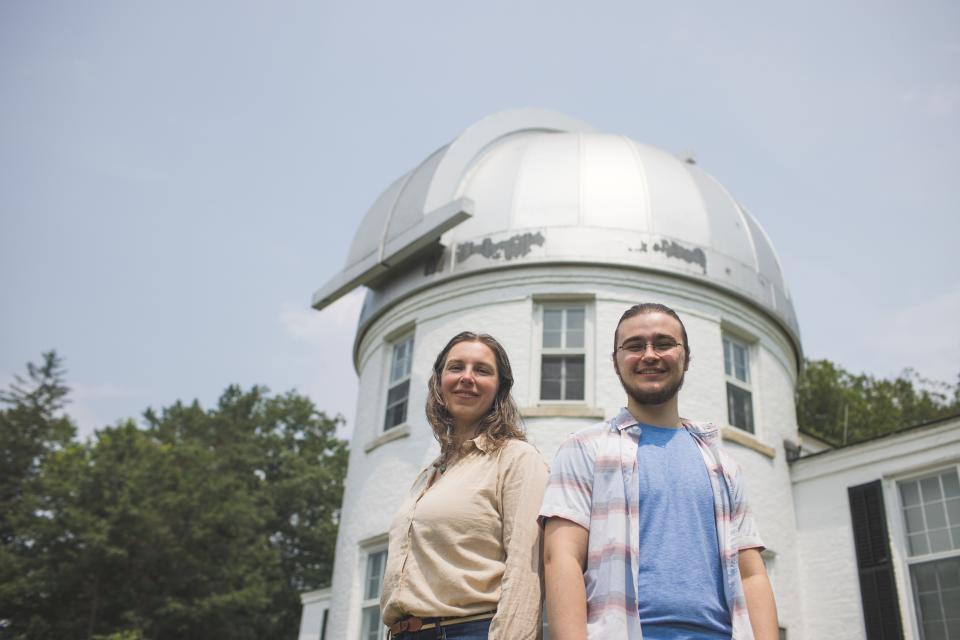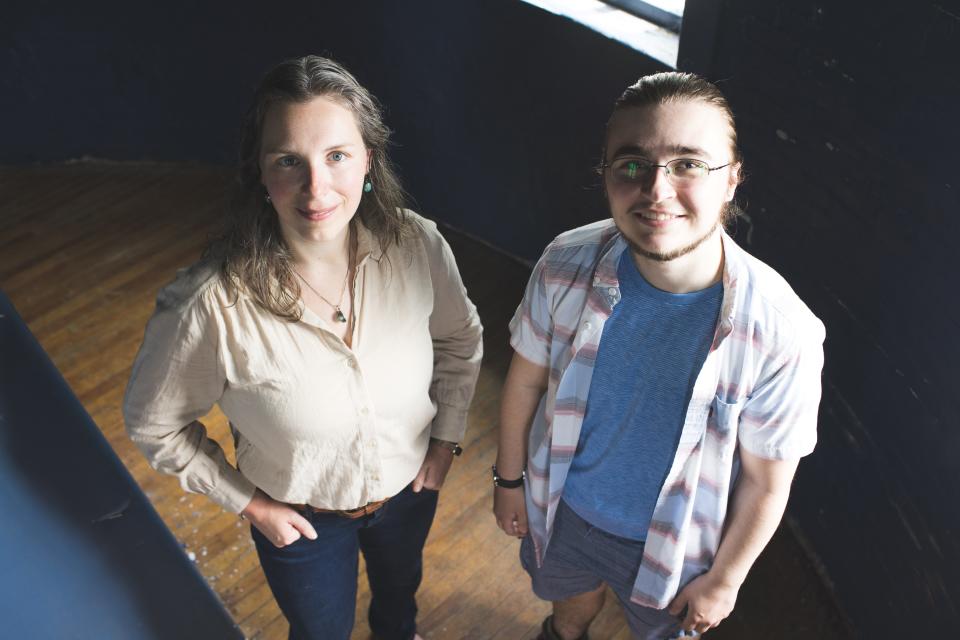Vermonter searches the stars and makes a galactic discovery times two
Imagine making a major scientific discovery before your career has even begun. That's the reality for one Vermont native, whose passion for space is paying off even earlier than intended.
Jack Duranceau, who is from Queechee and attended Hartford High School, finished his undergraduate degree at Dartmouth College in Hanover, New Hampshire, this spring with the discovery of two exosolar planets added to his résumé.
Finding planets outside the earth's solar system − exosolar planets − isn't all that rare, but the type of system he studied makes this discovery significant. These planets can help researchers understand how planetary systems evolve over time, and could provide clues to our own history.

'Now it's time for us to fly' - prescient words from then-high school graduate
Duranceau's love for astronomy was sparked at a young age when his grandfather would take him to look at constellations in darkened fields of rural Pennsylvania. His passion reignited in high school after his freshman year when he attended an astronomy themed course with the Governor's Institutes of Vermont, where he learned how to process spectral data recorded by telescopes.
He took his astrophysics knowledge and paid it forward, creating a resource for his peers − which was mentioned in a Valley News article featuring his high school's 2019 graduation class. He also built a telescope he donated to the school. However, a global pandemic meant the disused instrument was given back to him.
In his salutatorian speech he compared himself and his classmates to pigeons who are skilled navigators and resilient. Those qualities would become even more important as he entered Dartmouth and his second semester became the first of many to be impacted by COVID.
“We are the pigeons of 2019 and now it’s time for us to fly,” he said in his high school graduation speech, according to the news article. Despite the challenges, it seems fly he did.
From data distillation to discovery − how a computer model turned Duranceau into an explorer
As part of his senior project, Duranceau discovered a two planet solar system about 257 light years away from our own − in our neighborhood, so to speak, within the Milky Way galaxy. TOI 3353b and TOI 3353c, as they are identified, are Neptune-like in size, orbiting a star similar to our sun.
The discovery took about a year of focus on the project because a computer model, data analysis, and lots of trial and error was involved.

In order to "see" a planet in the vast darkness of space, telescopes trained on stars look for a slight dip in brightness at regular intervals, which is the telltale sign that a planet might be passing between the star and the telescope, obscuring the light by hundredths of a percent. NASA's Transiting Exoplanet Survey Satellite (TESS) monitors stars for this purpose and flags ones which are good candidates for having a planet, but an astronomer must evaluate the data to prove there is one.
In this case, Duranceau looked specifically for exosolar planets in a young solar system, one that is less than a billion years old. He adapted computer models to determine if the star was young and sought mathematical justification to describe the planets. Elisabeth Newton, Duranceau's advisor on the project and professor of physics and astronomy at Dartmouth, said Duranceau figured out how to reduce the data being evaluated and used a Python coding tool that shortened the time the computer needed to process an individual star's data from 45 minutes to 10 minutes each. He spent much of his time inputting variables guessing at how big the planets were, how far away from their star, orbit duration and other factors, running the calculations until all the variables fit and he had a good idea of what type of planets he'd found.
Newton said Duranceau's coding and algorithmic skills contributed to the automation which he is now teaching to other students.
Why studying young solar systems is an important and emerging scientific frontier
About 5,000 exoplanets have been discovered, but only around 30 reside in young solar systems; Dartmouth has made nine of those discoveries. Newton is part of a group of researchers studying young planets, called the TESS Hunt for Young and Maturing Exoplanets (THYME).
"Astronomers love their acronyms," Duranceau said.
Much of our knowledge about planetary systems comes from studying old, stable stars. However, during the first 100 million years, systems are in the midst of the most exciting part of their evolution, according to Duranceau and Newton. The newly discovered system is about 22 million years old, compared to ours which is roughly 4.5 billion.
"They're the rambunctious teenagers, so they're difficult to work with, you could say," Duranceau said.
"It's also a really interesting age because young planets are bombarded by a lot of high energy radiation from their host stars and that radiation can impact planetary atmosphere, driving it off and causing atmospheric mass loss," Newton said.
Examining planets during a snapshot in time while they are still settling helps us understand how systems form and change over time. The broader implications could explain more about our own system's history and why other planetary systems developed differently from ours.

In the case of Duranceau's exoplanets, they are similar in size, and possibly composition to Neptune, but are much closer to their sun than even Mercury is in our system. For relative comparison, Earth is considered one astronomical unit away from our sun. Mercury is 0.4 units to the sun. Duranceau's exoplanets are 0.05 and 0.08 units from their star. Their years − the length of time it takes to make one orbit around their star − are 4.6 and 8.8 earth-days long.
This star could serve as an analog for ours; it's about the same in mass, radius and brightness. Yet these large planets are close to their sun and very hot, which is opposite the make up of our system.
"We've got these huge planets that are super close and it's like how did they get there? Did they form there? Did they form further out and move in?" Duranceau said there is a lot they're still trying to figure out. "Could our own solar system have looked like this one − maybe Jupiter and Saturn and Neptune and Uranus were much closer to the Sun and then moved out?"
Finding two planets in one system also provides a controlled experiment, according to Newton, because the planets have the same star, history and age which is ripe for further research.
A change in trajectory: how this discovery changes Duranceau's plans but could spur new opportunities
The 22-year old graduated in June with an undergraduate degree with a double major in physics and astronomy and a minor in applied math. He intended to pursue a Ph.D. in astrophysics and ultimately work in astronomy research.
This discovery alters his course somewhat. He will take a gap year to further his research at Dartmouth while also applying to graduate schools. He will be employed by the college for a nine-month appointment during which he plans to write a scientific paper confirming planethood.
Newton said she loves working with the next generation of scientists, watching them discover a passion for astronomy that becomes part of their future. And it's exciting when a local student excels and stays.
"He lives in the next town over from me," Newton said about Duranceau. "Dartmouth draws students from around the country and around the world. There is something special when someone from the area, and not from Hanover, decides to stay."
Duranceau said he is just starting to soak in how big of a deal this is.
"When I was in the weeds of it, you lose sight of how cool a project it is," he said. He said the reception surprised him. "It's been really cool and rewarding to see people take an interest."
He said he can't officially name the planets he discovered, like has been done with stars. But, if he could, he'd name them June and Caspian, after his two cats.
Contact reporter April Barton at abarton@freepressmedia.com or 802-660-1854. Follow her on Twitter @aprildbarton.
This article originally appeared on Burlington Free Press: Vermont native and Dartmouth student discovers young exosolar planets

